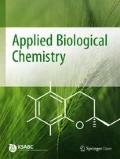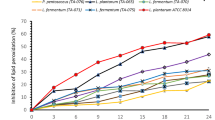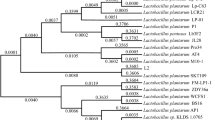Abstract
Polyamines are well known as important molecular compounds for many biochemical processes in animals and plants. The function of biogenic polyamine has been especially well studied for its role in the oxidative system and the protection of membranes from peroxidation in cells. We investigated the polyamine contents of fluke babsikhae and isolated polyamineproducing lactic acid bacteria (LAB) to improve the probiotic antioxidative function of the Korean traditional fermented food, fluke babsikhae. In the present study, first we confirmed that fluke babsikhae possesses more antioxidative molecules compared to the other antioxidative vegetable (Korean radish) and ascorbic acid by using the method of peroxide value (POV). Secondly polyamines, which are considered as antioxidative molecules, were detected in fluke babsikhae using thin layer chromatography (TLC) and high performance liquid chromatography (HPLC). In order to improve the probiotic function of fluke babsikhae, LABs were isolated from the fermented food, and these isolated microbes were tentatively identified as Lactobacillus brevis strain bh3 and Lactobacillus sp. using 16S rRNA sequencing. Polyamine was produced from these two strains and also was confirmed to have antioxidative activity. Especially Lactobacillus sp. was shown to produce high amounts of putrescine. Therefore, this strain can be considered as a starter to improve the probiotic function of fluke babsikhae. According to the results, fluke babsikhae will be a good candidate for a healthy functional food and also isolated LAB will be considered as a starter for probiotics by bioconversion.
Similar content being viewed by others
References
Brink B, Damiric C Joosten J, and Huis in’t Veld J (1990) Occurrence and formation of biologically active amines in food. Int J Food Microbiol 11, 73–84.
Cha YJ, Lee CE, Jeong EK, Kim H, and Lee JS (2002) Physiological Functionalities of Traditional Alaska Pollack Sikhae. J Korean Soc Food Sci Nutr 31, 559–565.
Choi C, Lee HD, Choi HJ, Son JH, Kim S, Son GM et al. (2001) Functional and Volatile Flavor Compounds in Traditional Kyungsangdo Squid sikhae. Korean J Food Sci Technol 33, 345–352.
Elvira L, Maria SM, and Salvador Z (2007) Biological significance of dietary polyamine. Nutrition 23, 87–95.
Gros C and Labouesse B (1969) Study of the Dansylation Reaction of Amino Acids, Peptides and Proteins. Eur J Biochem 7, 463–470.
Hwang CW, Shin HK, Do MS, Kim YJ, Park JH, Choi YS et al. (2001) The various biofunctional effects (anticarcinogenic, antioxidative and lypolytic activity) of Pohang buchu. Korean J Food Sci Technol 33, 279–281.
Hwang DF, Chang SH, Shiua CY, and Chai TJ (1997) High-performance liquid chromatographic determination of biogenic amines in fish implicated in food poisoning. J Chromatogr B: Biomed Sci Appl 693, 23–30.
Lovaas E (1991) Antioxidative effects of polyamine. J AmOil Chem Soc 68, 353–358.
Martin Křížek, František Vácha, and Tamara Pelikánová (2011) Biogenic amines in carp roe (Cyprinus carpio) preserved by four different methods. Food Chem 1126, 1493–1497.
Özogul F, Taylor KDA, Quantick P, and Özogul Y (2002) Biogenic amines formation in Atlantic herring (Clupea harengus) stored under modified atmosphere packaging using a rapid HPLC method. Int J Food Sci Tech 37, 515–522
Author information
Authors and Affiliations
Corresponding author
Rights and permissions
About this article
Cite this article
Choi, Jh., Hwang, Cw., Do, Hk. et al. Anti-oxidizing functional effect of polyamine as a bioconversion starter using microbes isolated from fluke babsikhae. J Korean Soc Appl Biol Chem 56, 83–86 (2013). https://doi.org/10.1007/s13765-012-2241-z
Received:
Accepted:
Published:
Issue Date:
DOI: https://doi.org/10.1007/s13765-012-2241-z




